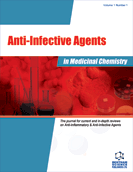Abstract
The situation of tuberculosis disease has recently been complicated by the human immunodeficiency virus epidemic and the increased prevalence of multi-drug resistant strains of Mycobacterium tuberculosis. The new drugs which are affordable and more effective compared to clinically used, are required to target resistant strains of M. tuberculosis and emerging pathogens, such as M. avium complex. Most of the reported natural products exhibited antimycobacterial activity against whole mycobacteria species viz. M. tuberculosis, M. avium complex and M. bovis. An analysis of the literature examples of target-based natural products reveals insights into mechanism of their antimycobacterial activity that might help medicinal chemists to design and develop novel antimycobacterial compounds. In the present review the attempt has been made to cover target-based natural products that exhibited antimycobacterial activity. The enzymes involved in the metabolism of mycolic acids represent attractive targets for the design of new anti-mycobacterial agents, as mycolic acids are vital in bacterial survival. The antimycobacterial targets such as β-ketoacyl-acyl-carrier protein synthases, KasA and KasB (belong to the fatty-acid synthase type II system involved in fatty acid and mycolic acid biosynthesis), inhA, an enoyl-acyl carrier protein (ACP) reductase, mycothiol-S-conjugate Amidase (MCA) and inhibitors (of natural product origin) acting on these are discussed in detail.
Keywords: Mycobacterium tuberculosis, natural products, mycolic acids, β-ketoacyl-acyl-carrier protein synthases KasA, KasB, mtFabH, an enoyl-acyl carrier protein reductase (inhA), mycothiol-S-conjugate amidase
 8
8





















